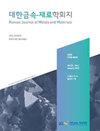Thermomechanical Behavior and Microstructure Properties of Carbon Fiber Reinforced Polymer at Elevated Temperatures
IF 1.4
4区 材料科学
Q4 MATERIALS SCIENCE, MULTIDISCIPLINARY
引用次数: 0
Abstract
Carbon fiber reinforced polymer (CFRP) has been extensively used in civil engineering for applications such as reinforcing and retrofitting various architectural materials. Therefore, understanding the degradation of CFRP under high temperatures is important. This study aims to investigate the thermomechanical and microstructural properties of CFRP plates at elevated temperatures up to 350 oC. The platetype CFRP composites were subjected to temperatures of 50, 100, 150, 200, 250, 300, and 350 oC, and then compared with pristine CFRP samples. X-ray diffraction analysis was conducted to examine the crystal structures of the carbon fibers and epoxy resin matrices in the CFRP. At temperatures higher than 150 oC, the FWHM increased due to the degradation and softening of the resin matrix. Delamination and debonding between the matrix and fibers were observed in samples exposed to temperatures above 200 oC. The maximum tensile strength of the CFRP plates exposed at 350 oC significantly decreased to 0.605 GPa, a reduction of approximately 40% compared to the pristine sample. On the other hand, Young's modulus remained relatively unchanged across the different temperatures. This suggests that the polymer matrix degradation plays a crucial role in the mechanical properties of CFRP, as the matrix layers contribute significantly to the distribution of forces.碳纤维增强聚合物在高温下的热力学行为和微观结构特性
碳纤维增强聚合物(CFRP)已广泛应用于土木工程,如加固和改造各种建筑材料。因此,了解 CFRP 在高温下的降解情况非常重要。本研究旨在探讨 CFRP 板材在高达 350 摄氏度的高温下的热力学和微观结构特性。将板型 CFRP 复合材料置于 50、100、150、200、250、300 和 350 oC 的温度下,然后与原始 CFRP 样品进行比较。对 CFRP 中的碳纤维和环氧树脂基质的晶体结构进行了 X 射线衍射分析。当温度高于 150 oC 时,由于树脂基质的降解和软化,FWHM 增加。在温度超过 200 oC 的样品中,基体和纤维之间出现了分层和脱粘现象。暴露在 350 oC 温度下的 CFRP 板材的最大拉伸强度明显降低至 0.605 GPa,与原始样品相比降低了约 40%。另一方面,杨氏模量在不同温度下保持相对不变。这表明聚合物基质降解对 CFRP 的机械性能起着至关重要的作用,因为基质层对力的分布起着重要作用。
本文章由计算机程序翻译,如有差异,请以英文原文为准。
求助全文
约1分钟内获得全文
求助全文
来源期刊

Korean Journal of Metals and Materials
MATERIALS SCIENCE, MULTIDISCIPLINARY-METALLURGY & METALLURGICAL ENGINEERING
CiteScore
1.80
自引率
58.30%
发文量
100
审稿时长
4-8 weeks
期刊介绍:
The Korean Journal of Metals and Materials is a representative Korean-language journal of the Korean Institute of Metals and Materials (KIM); it publishes domestic and foreign academic papers related to metals and materials, in abroad range of fields from metals and materials to nano-materials, biomaterials, functional materials, energy materials, and new materials, and its official ISO designation is Korean J. Met. Mater.
 求助内容:
求助内容: 应助结果提醒方式:
应助结果提醒方式:


